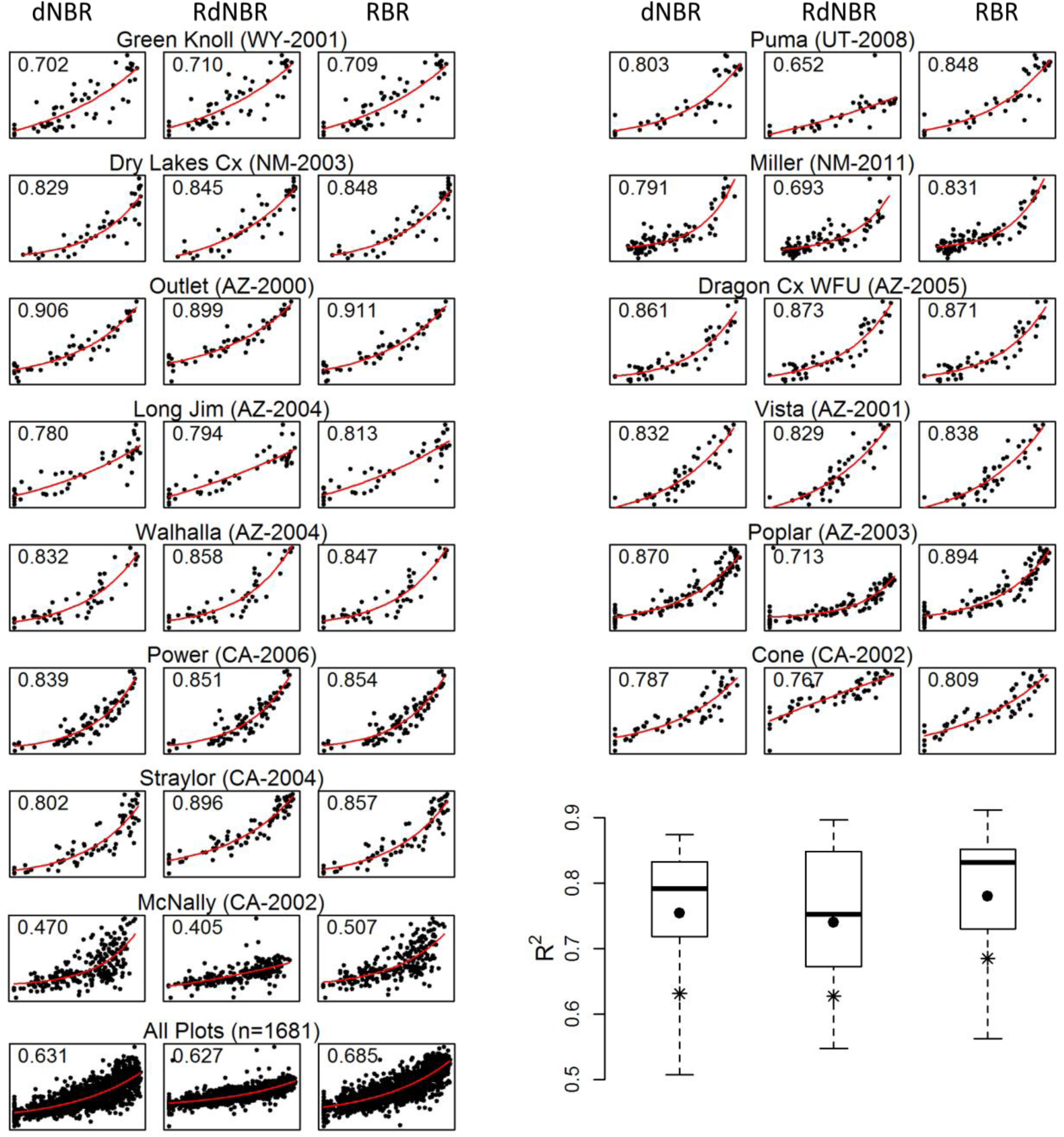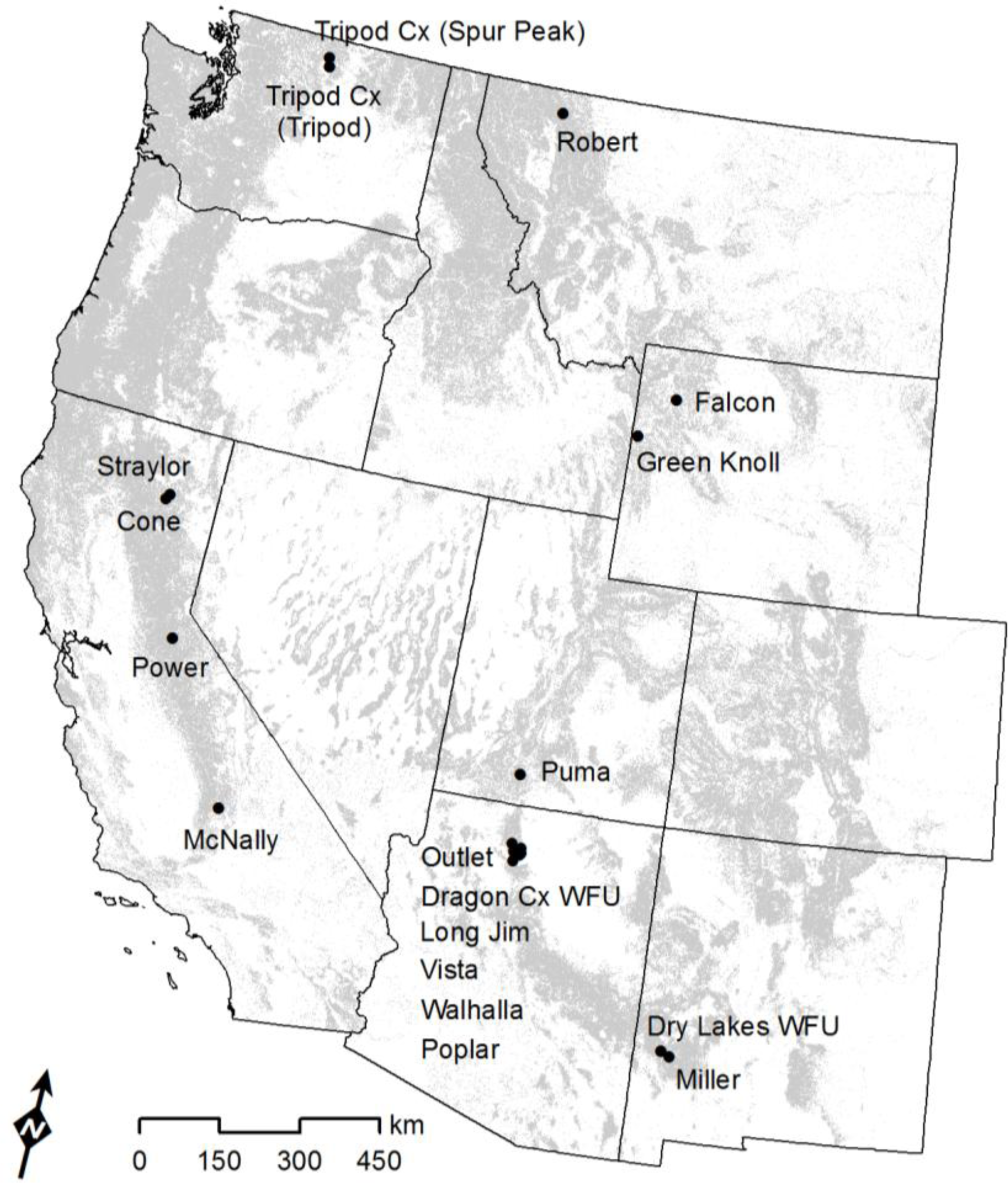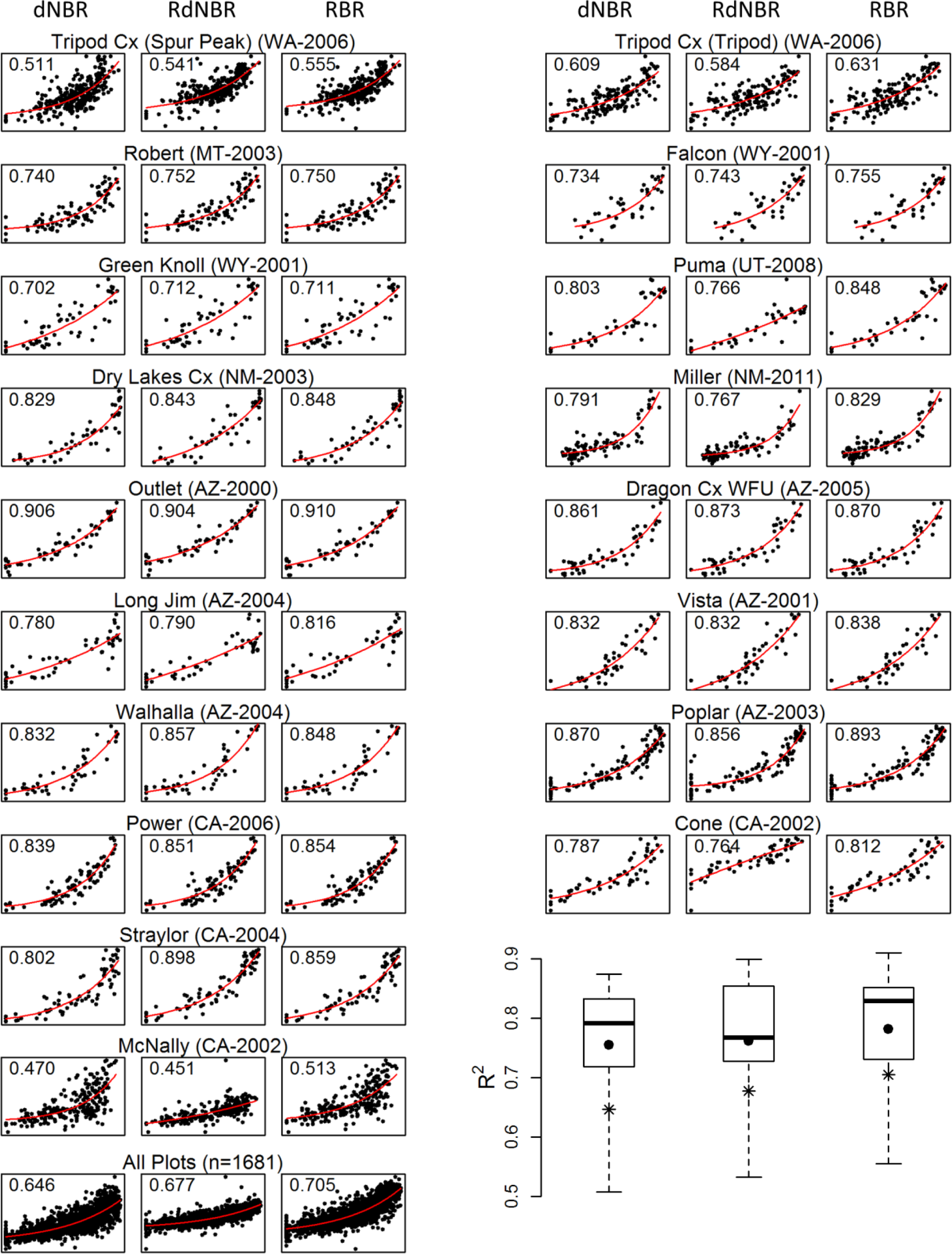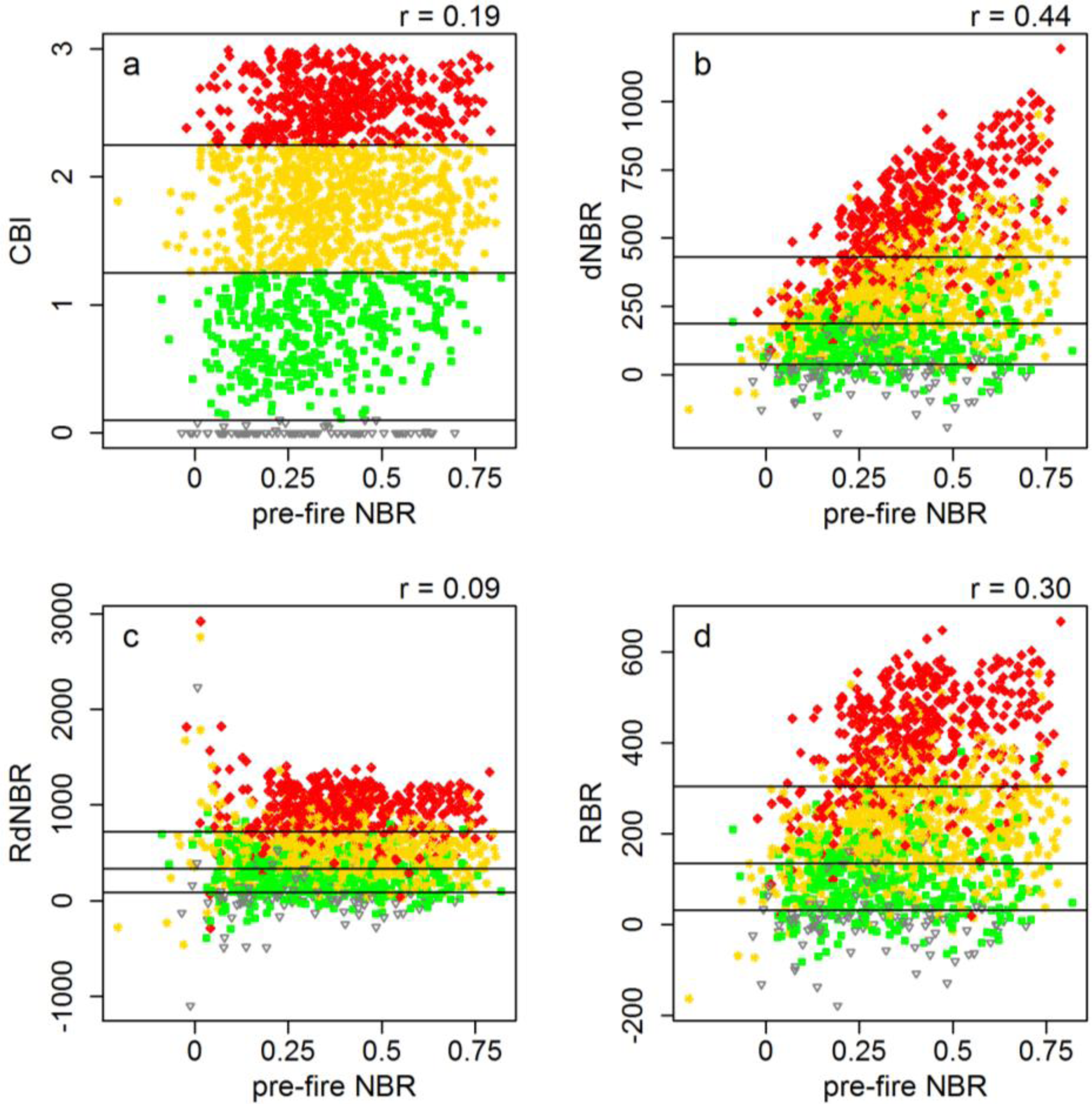1. Introduction
Over the last decade, substantial time, effort, and money have been invested in developing satellite-inferred wildfire burn severity maps. Imagery from the Landsat TM and ETM+ sensors have been particularly useful for this purpose due to their 30 m spatial resolution,
ca. 16-day temporal resolution, and a deep catalogue of publicly-available images dating back to 1984. Landsat images and burn severity maps derived from them have been invaluable for developing an atlas of burn severity for large fires in the US [
1], determining the drivers of burn severity [
2–
4], measuring the effect of past disturbance and management on burn severity [
5–
7], and quantifying the effects of fire on biotic communities [
8].
Consistent with major burn severity mapping efforts [
1], we define burn severity as the degree of fire-induced change to vegetation and soils, as measured with Landsat-based metrics. The two most commonly used Landsat-based metrics of burn severity are the delta normalized burn ratio (dNBR) [
9] and its relativized form (RdNBR) [
10], both of which rely on the normalized burn ratio (NBR) (
Equation (1)). NBR is sensitive to the amount of chlorophyll content in plants, moisture, and char or ash in the soil. The equations for dNBR (
Equation (2)) and RdNBR (
Equation (3)) use NBR derived from pre- and post-fire satellite images to quantify spectral change. Both metrics are sensitive to changes commonly caused by fire [
11–
13] and are often strongly correlated to field-based measures of burn severity [
14–
16]. Although maps of dNBR and RdNBR provide depictions of landscape change on a continuous scale, researchers and practitioners commonly classify these continuous metrics into categorical maps representing unchanged, low, moderate, and high burn severity (e.g., [
10]).
* These bands are specific to Landsat 5 and 7 and are not valid for other satellites such as MODIS and Landsat 8.
The equations for both dNBR and RdNBR make slight and important adjustments to the simple difference between pre- and post-fire NBR. The dNBR
offset in
Equation (2) is the average dNBR value from pixels in relatively homogenous, unchanged areas outside the burn perimeter and is intended to account for differences due to phenology or precipitation between the pre- and post-fire images [
10,
17]. Although the dNBR
offset is not always used when generating dNBR maps [
1], it becomes important when comparing dNBR among fires [
17]. The denominator in
Equation (3) is what makes the RdNBR a metric of relative, rather than absolute, change, thus emphasizing change relative to the amount of pre-fire vegetative cover [
10].
A relativized version of burn severity is advantageous in certain situations. Miller and Thode [
10] clearly articulated the main argument for a relativized version of burn severity such as RdNBR: pixels whose pre-fire vegetative cover is low (
i.e., low NBR) will generally have low dNBR values regardless of the degree of fire-induced mortality of the vegetation. As an absolute measure of change, dNBR simply does not allow for the quantification of high severity in these cases, even if all pre-fire vegetation is consumed. As a result, dNBR values are often correlated to pre-fire NBR. The denominator in the equation for RdNBR (
Equation (3)) removes this correlation and allows the metric to be more sensitive than dNBR to changes where pre-fire vegetation cover is low. As such, a relative index like RdNBR is theoretically more suited to detect changes to vegetation on a consistent scale.
Mathematically, however, there are several difficulties associated with the RdNBR denominator (
Equation (3)). First, the square root transformation causes very small values of pre-fire NBR to produce extremely high or low (
i.e., negative) values of RdNBR [
10]. The meaning of such extreme values is difficult to interpret since they appear as outliers compared to most RdNBR values and are more due to very low pre-fire NBR values as opposed to the amount of fire-induced change. Furthermore, the RdNBR equation reaches infinity, and therefore fails, when the pre-fire NBR equals zero, requiring that pre-fire NBR values of zero be replaced with 0.001 ([
18]). Lastly, the absolute value transformation of the pre-fire NBR term converts negative pre-fire NBR values to positive values. This transformation adds ambiguity to the resulting RdNBR values by not fully accounting for the variation in pre-fire NBR. Negative pre-fire NBR values comprise a small proportion of
most fires (<1%) and correspond to areas with very little to no vegetation [
10]; in dry ecosystems, such values occasionally comprise over 10% of the area within a fire perimeter [
1].
The use of dNBR
vs. RdNBR is actively debated [
19–
21] and results regarding which metric better corresponds to field-based burn severity data have been inconclusive [
11,
19]. Some studies have concluded that RdNBR provides higher classification accuracies than dNBR when discrete classes (
i.e., low, moderate, and high) of burn severity are required [
10,
21]. Other studies have concluded that dNBR generally performs better than RdNBR, both in terms of correspondence with field measurements and classification accuracies [
12,
19].
The goal of this study was to propose and evaluate an alternative relativized burn severity metric that is sensitive to changes where pre-fire vegetation cover is low but avoids the difficulties associated with the RdNBR equation; we call this new metric the relativized burn ratio (RBR). We examine 18 fires from across the western US and evaluate the ability of RBR to characterize burn severity in terms of its correspondence to a continuous field-based measure of burn severity and its overall accuracy when classifying into discrete burn severity classes (i.e., unchanged, low, moderate, and high). We also conducted parallel analyses using dNBR and RdNBR in order to determine if RBR improves upon either metric.
4. Discussion
Overall, RBR better corresponded to field-based burn severity measurements and had higher classification accuracy compared to dNBR and RdNBR. Although there were individual fires where other metrics (particularly RdNBR) performed better than RBR, when the evaluations were averaged among the 18 fires and when all plots were lumped and analyzed simultaneously (including the five-fold cross-validation), RBR always performed best. Our evaluation included fires throughout the western US in forests with fire regimes ranging from predominately low-severity surface (e.g., Miller) to stand-replacing (e.g., Green Knoll), suggesting that RBR is a robust severity metric that can be used across broad geographic regions and fire regimes.
Like RdNBR, RBR is a relativized version of dNBR, designed to detect change even where pre-fire vegetation cover is low. We demonstrated that both RBR and RdNBR are less correlated to pre-fire NBR than is dNBR, indicating that the relativized metrics are better at detecting high severity effects across the full range of pre-fire vegetation cover. Areas of relatively sparse or spatially discontinuous vegetation are fairly common throughout the western US and will potentially become more common as climate becomes more arid and fire becomes more frequent [
24,
25]. Accurately characterizing burn severity in such areas will become increasingly important. Our study supports the use of a relativized form of the dNBR equation; on average, RBR or RdNBR performed better than dNBR. However, the choice between using an absolute (
i.e., dNBR)
vs. relativized (e.g., RBR) remotely sensed measure of burn severity should depend upon the objectives of any particular study, paying special attention to what is being measured by each metric.
Excluding the dNBR
offset from the burn severity equations can affect performance of the remotely sensed burn severity metrics. When dNBR
offset was excluded, we found lower correspondence to CBI field data for all three burn severity metrics when plots from all 18 fires were evaluated simultaneously (
Figure A1,
Appendix). Furthermore, classification accuracies were generally lower when the dNBR
offset was excluded. These findings support the assertion by Miller and Thode [
10] that, when making comparisons among fires, regardless of which burn severity metric is used, incorporating the dNBR
offset should be considered.
The RBR is an improvement upon RdNBR in terms of correspondence to field measures of burn severity and overall classification accuracy. Although this improvement may appear marginal, one of the key strengths of the RBR equation is that it avoids some of the mathematical difficulties associated with the RdNBR equation. That is, the RBR
equation (1) does not fail (
i.e., reach infinity) for any pre-fire NBR value (including zero), (2) does not result in extremely high or low values when pre-fire NBR is near zero, and (3) retains the sign of pre-fire NBR, thereby avoiding potential arbitrary bias of taking the absolute value. Furthermore, the reduced variability in RBR thresholds values among fires indicates that RBR thresholds are more “stable” compared to RdNBR thresholds and are thus more transferable among fires and ecoregions.
There have been several recent developments relating to remote sensing of fire effects, such as hyperspectral analysis [
14,
26], linear spectral unmixing [
27], and the use of other satellite platforms [
28]. While there is promise in these new remote sensing methods that may lead to a more ecologically-linked metric for remotely sensing burn severity in the long run, these other approaches have not been shown to perform better than Landsat-based dNBR or RdNBR when validated with CBI field data (e.g., [
14,
28]). For the time being, therefore, Landsat-based severity metrics such as RBR, dNBR, and RdNBR remain relatively robust compared to these emerging approaches.
It has also been noted that differences in geography, ecosystem type, and pre-fire soils can influence satellite-inferred burn severity metrics [
29–
31]. As such, some have suggested that a suite of methods will ultimately be needed to adequately quantify burn severity, with different approaches optimized for different settings [
27]. Indeed, our data indicate that all remotely-sensed burn severity metrics evaluated in this study had higher correspondence to field data in the southwestern US compared to the other geographic regions we analyzed. This said, even when we lumped all our data, the correspondence of RBR and field data was strikingly high (r
2 = 0.705 for all plots), indicating that RBR is a useful metric across the range of geography and ecosystem types covered in our study. Because we limited our study to forested areas in the western US, it is unclear if RBR is a valid burn severity metric in other geographic regions (e.g., southeastern US, Canada, and Alaska).











